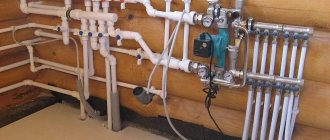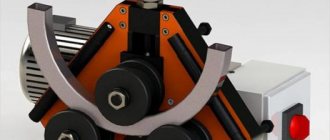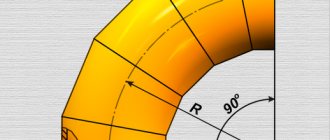Pipes are classified according to a large number of characteristics, the main ones are listed below:
- Material from which they are made: metal;
- reinforced concrete;
- polymer.
- suture;
- round;
- for high pressure;
This simplified diagram minimally shows the large family of this product as well as its wide range of applications.
The main task of joining pipes is to obtain a seam that is tight, durable, and reliable. They are divided into two types: detachable and one-piece:
- Detachable connections: threaded;
- flanged;
- bell-shaped
- welding;
Depending on the operating conditions, material, and geometric dimensions, the best connection method is determined.
Thread
Threaded connections are among the most ancient. They are used only on round pipes. Based on the direction of torsion, a distinction is made between right-handed and left-handed threads. The second is rarely used, only in special cases.
This type of joint is suitable for water, gas, and oil products.
The ends themselves are twisted using additional fitting coupling parts.
Couplings are standard with internal threads on both sides. There are also combined ones, internal on one side and external on the other.
Threaded connection of steel pipes
General information
Methods for connecting steel pipes. Steel pipes are connected in a permanent or dismountable way. It depends:
1.from the material from which the riser and pipes are made. Pipes can be made of metal, cast iron, glass, polymer materials, or copper.- 2.on the characteristics of the liquids that flow through the pipeline.
- 3.on the conditions in which the log houses operate.
Threadless methods include welding, cold welding to glue pipes, and connection using a flange.
The threaded method remains a common connection method. The method with bending the pipe is not suitable for this method; the elements are connected using tees, couplings, taps, etc.
The connection method using a union nut is considered special; it uses two methods at once: threaded and threadless.
Features of the threaded connection. Threaded connections are suitable for pipes made of steel or ductile iron. The thread is made using a die or on a lathe. Risers with thin walls use a type of rolled cylindrical thread. The pipes can simply be twisted together, or special adapters can be used.
To transport steam or water through pipes, cast iron structures are used. The ends of the pipes are equipped with thick sides, which provide greater tightness during installation. Steel elements are suitable for pipelines of any circumference with low pressure or free-flow sewerage. The pipes are not equipped with thickened sides.
Various fittings, nuts, plugs, as well as couplings and locknuts are considered auxiliary parts when connecting pipes of straight lines or plugs.
If you need to turn the pipe, use a tee or square.
Connecting structures made using threads are not always detachable. It happens that threaded pipes are welded to surfaces that do not move, thereby achieving increased strength. Thus, the connection loses its detachable properties and is called a permanent threaded connection. This species is very rare.
If the installation work of connecting elements using threads is carried out correctly, the plumbing system will last for many years without failure.
Detailed description of each method
Threaded
They can be done in several ways, the most common being squeezing.
The following tools will help you do this job:
- Pipe wrench.
- Coupling with internal thread.
- Seals for sealing. Maybe: hemp rope, FUM tape or sealant.
- Lock-nut.
Two pipes have external threads . We apply sealant to them. One has a longer thread length than the other. Where there are more turns the nut is screwed on until the end. Then the clutch. Then we screw it onto the second part, twisting it with the first one. When the coupling stops screwing, we support it with a locknut. Tighten with wrenches, carefully, so that the coupling does not burst.
Flanges
For a flange joint you will need:
- two flanges;
- paronite gasket;
- bolts, washers, nuts;
- keys;
- manual arc welding;
- level.
The flanges need to be welded. Avoid displacement; they must be in the same plane.
We catch using a horizontal level. We screw two bolts into the upper holes. We put the part on the edge of the tube so that the bolts are at the top. We put a level on them and catch the position of the bubble between the strips in the middle. When caught, we make a tack by welding at the top point. The horizontal plane is ready.
We rearrange the level to a vertical position, leaning it against the flange mirror. We catch the level by slightly adjusting the lower end of the flange that is not yet stuck. Having established the vertical, we installed the second tack. And then two more, resulting in four even sections.
Then the welder welds the flange on both sides. Manipulations are carried out similarly with the second pipe.
After welding, we get two pipes that can be connected. We insert four bolts into the holes from below and tighten them a little. We make a gap, insert a gasket. We insert four more bolts and tighten everything.
Bonding
This method is used very rarely in metal parts. The process itself does not require any special skill from a person, but it takes a lot of time.
This job requires:
- glue. BF-2 or 88N or EDP;
- brush.
Before gluing the parts, first apply the first layer on their surface and allow to dry. This layer will be the bonding layer. Each glue has a drying time written in its instructions. Then a second layer is applied and the parts are placed under the press for a day or even more. It all depends on the glue.
Then clean the seam from any glue leaks.
Crimp connectors for steel pipes
Welding
The welding process is used in almost all metal pipe joints.
In order to obtain a seam, the following welding methods are used:
- gas;
- electric arc;
- contact
Gas welding is used to obtain permanent connections in small diameter pipes with minimal thickness.
When welded in this way, it can also conduct water. The main thing is to test the seams for leaks after welding.
The gas welding station consists of:
- oxygen cylinder;
- acetylene;
- rubber hoses;
- burners.
Resistance welding is rarely used. This method has proven itself more effective in working with plastic pipes.
The most popular method of producing permanent joints is electric arc welding, divided into:
- manual
- semi-automatic in protective gas environment
When constructing pipelines, connections are made only by welding. An important part is preparing the joint for welding.
The pipe must be connected to another:
- no fractures or displacements;
- the joint must be cleaned;
- make a chamfer;
- set the gap to 1-3 mm.
Required welding equipment:
- electrodes;
- power source (transformer or rectifier);
- cable;
- Personal protective equipment for welders: overalls, mittens, brushes.
Soldering of polyethylene pipes end-to-end and using an electrofusion coupling
Trumpet
This type of connection is widely used in cast iron pipes for the oil and gas industry, housing and communal services. One of the simplest options for permanent joints.
The main process of obtaining a joint is to seal the gap between the socket and the surface of the conical pipe. Cement material is used for this.
First, a response pipe is inserted into the socket and then sealed with caulk, an airtight material. After the cement solution is diluted, the gap is tightly stamped with it.
To seal the socket, grade 300-400 cement is used, which is thoroughly mixed with water in a ratio of nine parts cement to one part water. The socket is filled with cement mortar using a scoop and embossed until the latter begins to bounce off the cement.
Pressing
This method of obtaining a permanent weld has become necessary for small-diameter connections made of non-ferrous metals. Conventional electric arc welding is not capable of welding such metals due to its technical parameters, so in this case they found a different approach.
In order to weld, you need to insert the prepared end into the fitting until it stops. Then treat its surface with a manual or hydraulic press.
To join such thin-walled non-ferrous metal pipes, press fittings with crimp sleeves are used. They perform crimping on the inside of the pipe, and external seals ensure the joint is sealed.
What is a pipe coupling?
A coupling is a type of fitting, designed to combine pipelines in straight sections; it is a short cylindrical part with a design that allows the connected elements to be securely and hermetically fixed inside its body.
All coupling fittings and adapters are designed to fix the outer surface; support fittings are usually located inside, to which the inner pipe casing is pressed. Depending on the material of the pipes, different types of couplings are used to connect them:
- steel products - connected with threaded fittings,
- polypropylene - by soldering,
- metal-plastic (cross-linked polyethylene) and low-density polyethylene - joined with compression fittings.
In the construction field, when underground pulling polyethylene communications, to obtain a high-strength and reliable joint, the ends are connected with electric welded couplings.
The latest breakthrough in technology has been the creation of push fittings, which are an alternative to compression crimp types. It should be noted that such coupling is easy to install - the pipe is permanently connected to the fitting by inserting into the fitting until it clicks; this process takes 1 - 2 seconds.
Advantages and disadvantages of each method
Thread
Advantages:
- reliability;
- ease of assembly, possibility of disassembly;
- low cost.
Flaws:
- tension in the thread cavities increases material fatigue, reducing its strength;
- the need to use locking means to prevent the working element from unscrewing.
Flanges
Advantages:
simplicity and convenience of reusable connection and disconnection.
Negative properties:
- high labor intensity in manufacturing, therefore, high price;
- with prolonged use, the location of its connection decreases, loss of tightness.
Bonding
The advantages of this method include its not labor-intensive process, which does not require much skill and effort.
But the wait for gluing sometimes reaches three days, which is not always convenient.
This type of connection cannot be considered a reliable method.
Welding
Advantages:
- reliability;
- durability;
- tightness;
- the ability to connect parts of any shape.
Flaws:
- the occurrence of residual stresses;
- possibility of changing geometry;
- risk of destruction under vibration and shock loads.
Trumpet
In comparison with all types, socket pipes have the advantage of low cost, the possibility of small axial and lateral movements of the pipe, which is very useful during temperature changes and soil shrinkage.
The negative indicator lies in the difficulty of connecting the connector and insufficient reliability at high pressure.
Pressing
A common positive factor is excellent self-centering of the joined parts and stable state under shock loads. A simple and non-labor-intensive process.
Cannot be disassembled or dislodged from each other. Here are a few disadvantages of this method.
Methods for connecting metal pipes
Pipeline assembly technology
To assemble the pipeline, you must perform the following sequence of actions:
- First, screw the coupling onto the pipe.
- Then the side with the short thread is screwed into the coupling (sometimes it is connected directly). The parts should be screwed all the way, then the connection will be reliable.
- A locknut is screwed onto the long side of the drive.
- Next comes the connecting fitting.
- Then the end of the drive is applied to the pipe and the coupling is screwed together so that it goes onto the pipe. The connection will be easier to complete if the axes of the parts coincide as much as possible.
- The fitting must then be secured with a locknut. To do this, it should be screwed to the coupling so that there is a distance of 2-3 cm between the parts. This space must be filled with strands of flax. They should be wound in the direction of rotation of the nut. Then the locknut should be tightened until it stops. This must be done to seal the connection and prevent water leakage through it. You should use a wrench to tighten the locknut because its edges are narrow.
Methods for connecting metal pipes to plastic
Areas of use:
- repair, replacement of old pipeline;
- construction, when installing a gas pipeline, plastic pipes are used, but in a residential area, gas should only be in metal pipes.
In such cases, several connection options are used:
- Welding-threaded. In this case, combined couplings are used. Here one side has a thread, the other a coupling. The thread connects to the metal end. The other side has a plastic end. Such adapters are used for small diameters.
- Flanged. For larger diameters, flanges are used. In some cases, metal hoses are used.
Tips and tricks
- When working with cast iron pipes, you must remember that they are fragile. For embossing and pressing, use rubber hammers.
- If the installation of a socket joint is carried out outdoors in hot weather , then when the cement is in the gap, it is suggested to lay a damp cloth on it. So that the cement does not crack.
- When gas welding, the flammable gas acetylene is used. If desired, it can be replaced with propane, which is cheaper and safer.
- When constructing a water or gas supply pipe system, try to weld the rotary joints first, and then, when the entire structure is assembled, weld the fixed joint last.
- When tightening the bolts on the flanges, do not overtighten. It is possible to strip the thread, this also applies to threaded connections.
Installation with threaded connection
How to connect iron pipes without welding will be discussed further, but in this article you can learn how to properly weld galvanized pipe products. To make docking, this method is very common.
The threaded connection can be located in places on the highway where conditions allow for constant monitoring of the joint. At the same time, it should be possible to carry out repair work if necessary.
Most often, threads are rolled using special equipment, but such work can be done independently.
It is performed in the following sequence:
- Cut off a piece of the workpiece, which provides the required allowance for the threaded part.
The pipe is secured to the die holder. A piece of metal workpiece is secured in a vice so that it does not rotate.- The die must be carefully attached to the end of the metal pipe. In this case, it is important not to make even a slight distortion, otherwise the thread will come out crooked and it will not be possible to connect the sections.
- For ease of operation, it is recommended to lubricate the workpieces with machine oil.
- When the die stops turning, it is recommended to perform one rotation in the opposite direction. This will remove the cut chips, which become an obstacle to moving forward.
- In a section that runs close to the wall, it is not always possible to make a full turn when cutting threads. In such situations, it is recommended to use a die holder with a ratcheting mechanism.
- To make a threaded connection reliable, you need to use a seal. For these purposes, plumbing winding will be used.
- Before tightening a threaded joint, it is worth checking the products for the presence of burrs and remaining chips. And the twisting itself must be done with a certain force.











